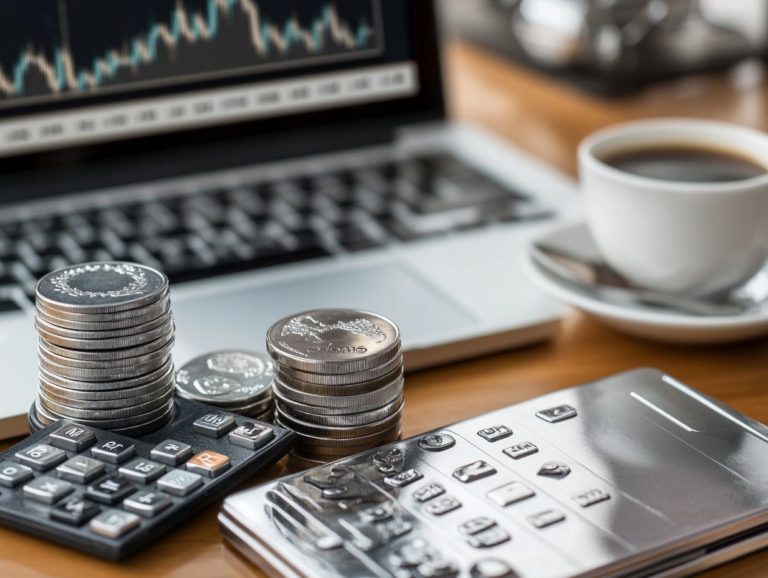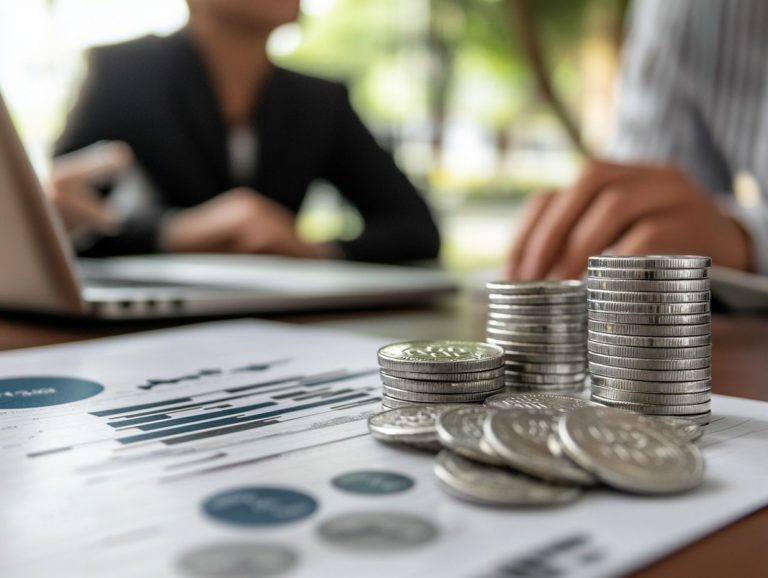7 Benefits of Investing in Physical Silver
Investing in physical silver presents you with a distinctive combination of security and potential growth, making it an appealing choice for both seasoned investors and newcomers alike.
In a landscape marked by rising inflation, market volatility, and increasing demand, silver emerges as a tangible asset that can significantly enhance your investment portfolio. This article delves into seven compelling benefits of investing in physical silver, highlighting its capacity to hedge against inflation protecting your money’s value when prices rise and its potential for price appreciation.
It also addresses practical considerations such as authenticity, storage, and tax implications, providing you with a thorough understanding of this valuable investment opportunity.
Contents
- Key Takeaways:
- 1. Hedge Against Inflation
- 2. Diversify Your Investment Portfolio
- 3. High Demand and Limited Supply
- 4. Tangible Asset with Intrinsic Value
- 5. Potential for Price Appreciation
- 6. Buy and Sell Silver with Ease!
- 7. Provides a Safe Haven during Economic Crisis
- What Is Physical Silver and How Does It Differ from Other Forms of Silver?
- What Are the Different Ways to Invest in Physical Silver?
- What Are the Risks Involved in Investing in Physical Silver?
- How Can One Determine the Authenticity and Purity of Physical Silver?
- Are you ready to dive into the exciting world of physical silver investment? What Are the Tax Implications of Investing in Physical Silver?
- How Can One Safely Store and Protect Their Physical Silver Investments?
- What Are the Long-Term Prospects for Investing in Physical Silver?
- Frequently Asked Questions
Key Takeaways:
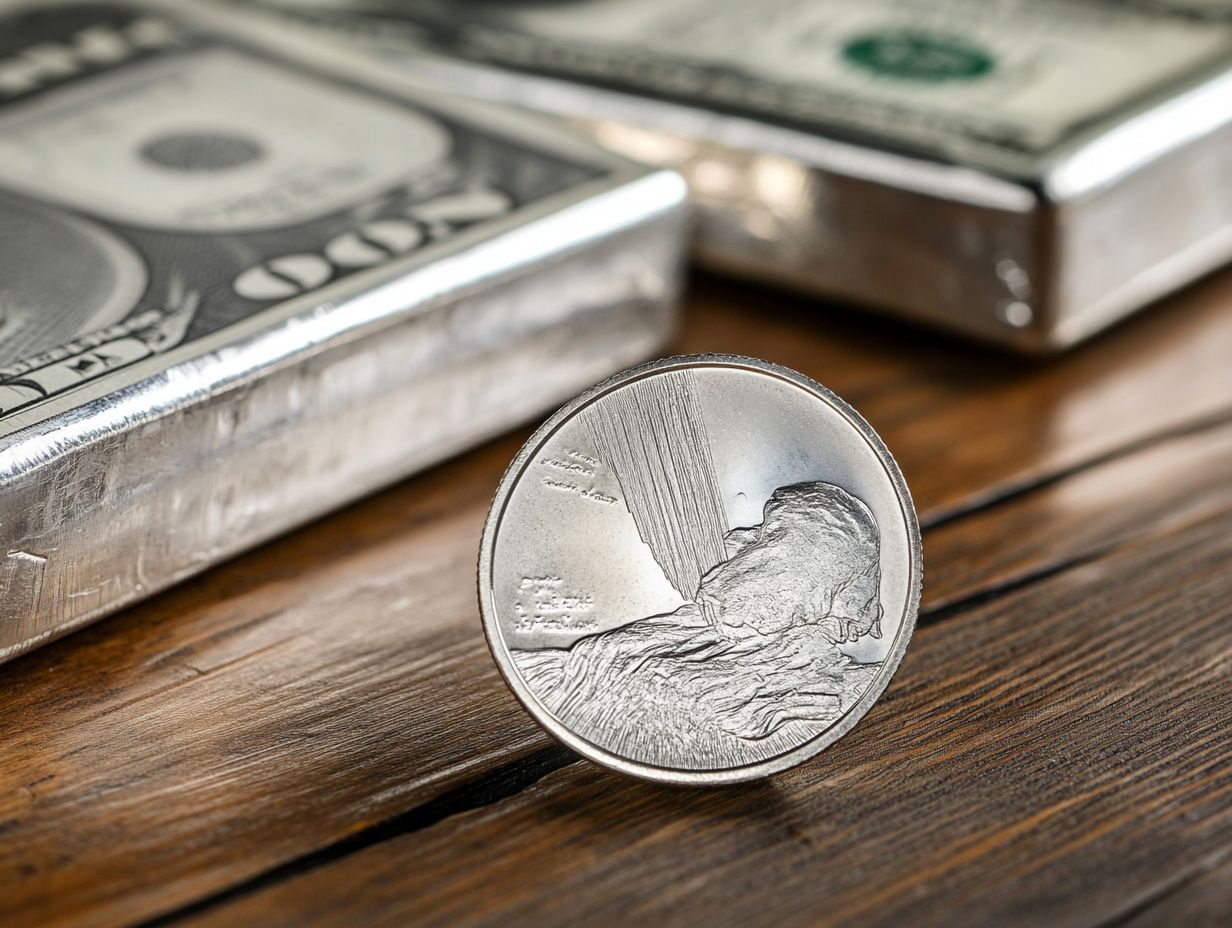
- Protect your wealth against inflation by investing in physical silver, which has historically held its value over time.
- Diversify your investment portfolio and reduce risk by including physical silver, which is less likely to move in the same direction as other assets.
- Supply and demand dynamics make physical silver a valuable asset with limited resources, making it a potentially profitable investment in the long run.
1. Hedge Against Inflation
Investing in silver is a smart move, especially when it comes to hedging against inflation. In times of economic uncertainty and rising consumer prices, silver prices can fluctuate, but as a tangible asset, physical silver tends to hold its value over time. This makes it an appealing option for anyone looking to secure their wealth and diversify their investment portfolio.
Historical data shows that silver has consistently outperformed other asset classes during inflationary periods, reinforcing its status as a reliable store of value. Take the 1970s, for instance high inflation rates saw silver prices soar, showcasing its protective qualities against escalating costs.
More recently, after the 2008 financial crisis, many investors flocked to silver as a safe haven. You could see similar patterns during the economic uncertainty brought on by the pandemic.
Additionally, sectors such as electronics and renewable energy have ramped up their demand for silver. This not only stabilizes its value but also offers the potential for price increases. This growing demand makes silver a must-have for anyone looking to protect their wealth in tough times!
2. Diversify Your Investment Portfolio
Diversifying your investment portfolio by including silver can significantly mitigate overall risk while enhancing your potential returns, particularly in a market marked by silver volatility and the rise of digital assets.
This strategic allocation serves as an effective hedge against inflation and protects you from market downturns, offering a safety net that traditional assets like stocks and bonds may not provide.
Incorporating silver into your portfolio not only introduces an element of security, but also taps into its historical significance as a reliable store of value.
For those venturing into the world of investing, silver ETFs (Exchange-Traded Funds) offer a straightforward yet powerful means to gain exposure without the complications of physical ownership. By embracing this approach, you can harness silver’s unique properties while confidently navigating the broader investment landscape. Additionally, exploring the financial benefits of tax-deferred precious metal accounts can further enhance your investment strategy.
3. High Demand and Limited Supply
The unique properties of silver, paired with its surging demand across diverse industries, present a compelling case for your investment consideration, particularly in an environment where silver supply is becoming increasingly constrained.
This demand is primarily fueled by silver’s critical role in electronics, where it excels as a conductor, and in photovoltaic energy systems, where it boosts the efficiency of solar panels. Additionally, the medical technology sector relies on silver s remarkable antimicrobial properties, making it essential for various health applications, from wound care to surgical instruments.
Navigating the challenges of silver production such as declining ore grades, environmental regulations, and logistical complexities adds another layer of intrigue, leading to a tighter supply chain. As a result, this dynamic landscape underscores the metal s vital importance and positions it as a potentially lucrative investment opportunity for you.
Act now to secure your financial future!
4. Tangible Asset with Intrinsic Value
Physical silver, including silver coins and bullion, is a tangible asset with intrinsic value. This makes it an appealing choice if you seek reliability and stability in your investment strategy.
Unlike digital assets, which can swing dramatically based on market sentiments and technological trends, silver has a rich historical legacy as a currency that spans centuries. This precious metal not only serves as a medium of exchange but also symbolizes wealth across various civilizations, reinforcing its vital role in wealth preservation.
In a world filled with uncertainties, many investors find comfort in holding a physical asset that has proven its worth over time. Silver provides security and serves as a way to protect your money from losing value due to rising prices, making it a compelling option in today’s investment landscape.
5. Potential for Price Appreciation
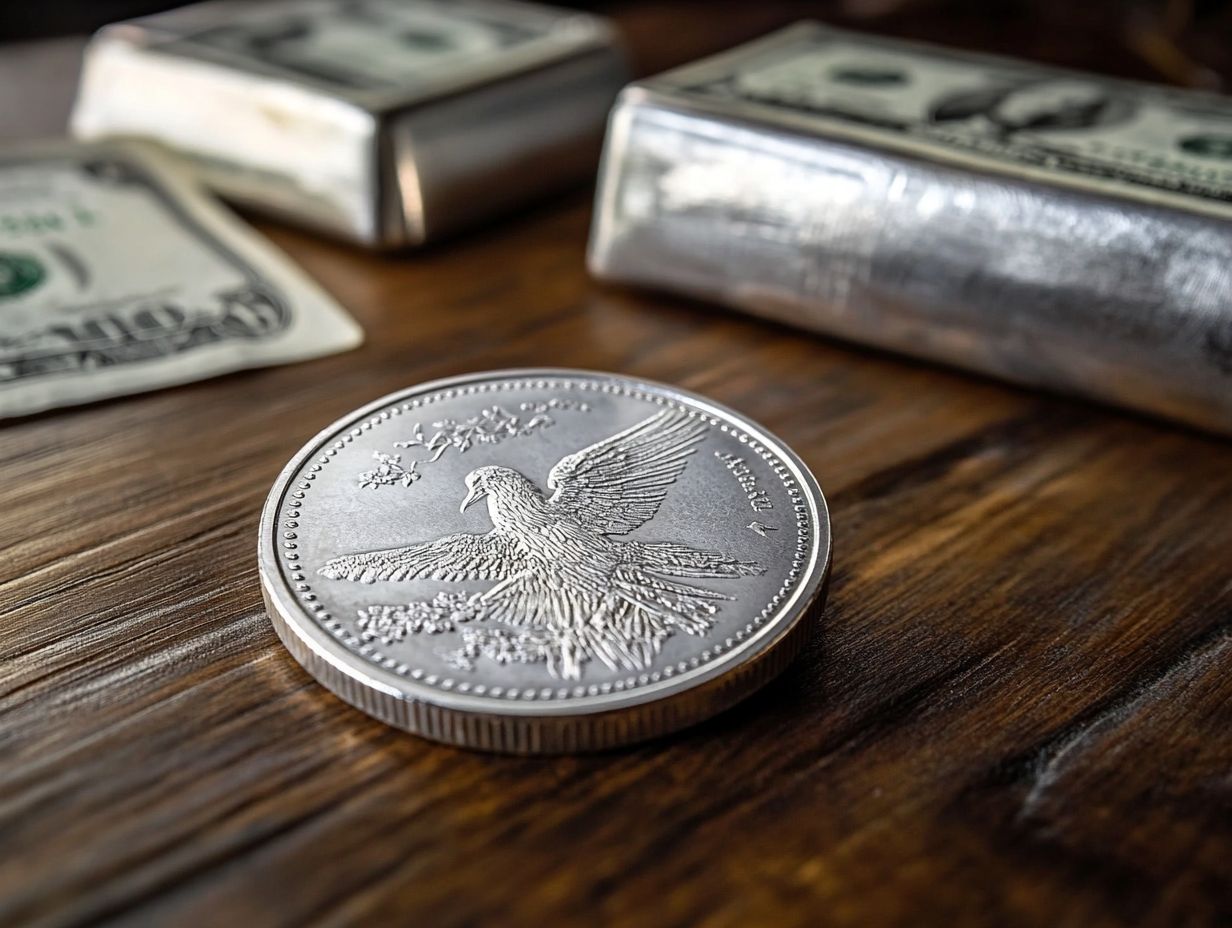
The potential for price appreciation in silver is significantly enhanced by its unique characteristics. Key factors include increasing demand, limited supply, and fluctuations in the silver-to-gold ratio, which make silver investments particularly appealing.
Many people notice that global economic conditions play a crucial role in shaping investor sentiment and market trends. When the economy is uncertain, many turn to silver as a safe-haven asset, driving up both its demand and price. Historical instances, like the dramatic price surge in the late 1970s, remind us that geopolitical tensions and inflation can lead to substantial gains for silver investors.
Recent trends suggest that as technology continues to advance and industrial consumption rises, the demand for silver may well outstrip its supply. This dynamic further enhances silver’s allure as an integral component of a diversified investment portfolio.
6. Buy and Sell Silver with Ease!
Investing in silver is remarkably straightforward. Silver coins and bars are readily available, and platforms like BullionVault make buying and selling easy.
Local dealers also provide a tangible way to engage with silver, enabling face-to-face transactions that often offer immediate liquidity. The liquidity of the silver market allows you to take quick action to buy or sell your precious metal holdings whenever the market conditions are right.
Auctions and peer-to-peer sales open opportunities for you to negotiate prices outside traditional retail channels, adding flexibility to your silver investment strategies. By understanding these various avenues, you simplify the process of acquiring and liquidating assets whenever needed.
7. Provides a Safe Haven during Economic Crisis
During economic crises, investing in silver can serve as your safe haven. Its value often remains stable or even appreciates, largely due to its historical role as a hedge against inflation and economic instability.
Throughout history, there have been key moments when silver prices surged dramatically, notably during the Great Depression and the 2008 financial crisis. Investors have instinctively turned to silver as a tangible asset, driven by a collective belief that precious metals can offer protection amid market turbulence. For those looking to navigate these investments, understanding the best practices for precious metals investment is essential. This tendency stems from psychological factors; when fear grips the markets, the allure of physical silver becomes hard to resist.
Silver not only preserves wealth but also stands as a reliable asset class that individuals gravitate toward in uncertain times. It represents a well-established strategy for safeguarding financial stability, reflecting the enduring wisdom of turning to precious metals when the economy feels shaky.
What Is Physical Silver and How Does It Differ from Other Forms of Silver?
Physical silver refers to tangible forms of silver, like coins and bars. It stands apart from other investment options such as silver ETFs, each with unique benefits tailored to different financial goals.
As you weigh the pros and cons of each option, consider your personal financial objectives. Physical silver offers intrinsic value and a palpable sense of ownership but comes with challenges related to storage and security. For insights on timing your investments, check out the best time to invest in precious metals. Silver ETFs, on the other hand, provide excellent liquidity, allowing easy buying and selling of shares without the hassle of managing physical assets. However, these financial instruments may lack the tangible allure and inherent value of actually holding the metal.
This comparison helps you determine which option aligns best with your risk tolerance and investment strategy.
What Are the Different Ways to Invest in Physical Silver?
There are several avenues for investing in physical silver, including purchasing silver coins, silver bars, and silver bullion. Each presents unique advantages and opportunities.
As a newcomer, it’s wise to familiarize yourself with the array of silver products available and the pros and cons of each option. Silver coins, often minted by government authorities, can carry collector’s value in addition to their intrinsic metal content. This dual appeal makes them a favored choice for both collectors and investors. Additionally, consider exploring the benefits of long-term gold investments to diversify your portfolio.
Conversely, silver bars typically feature lower premiums over spot prices, attracting those focused primarily on potential price appreciation. Before making any purchases, it’s essential to evaluate critical factors such as authenticity, market trends, and storage solutions. Understanding the benefits of investing in silver can also enhance this meticulous approach, ensuring a secure and profitable investment journey.
What Are the Risks Involved in Investing in Physical Silver?
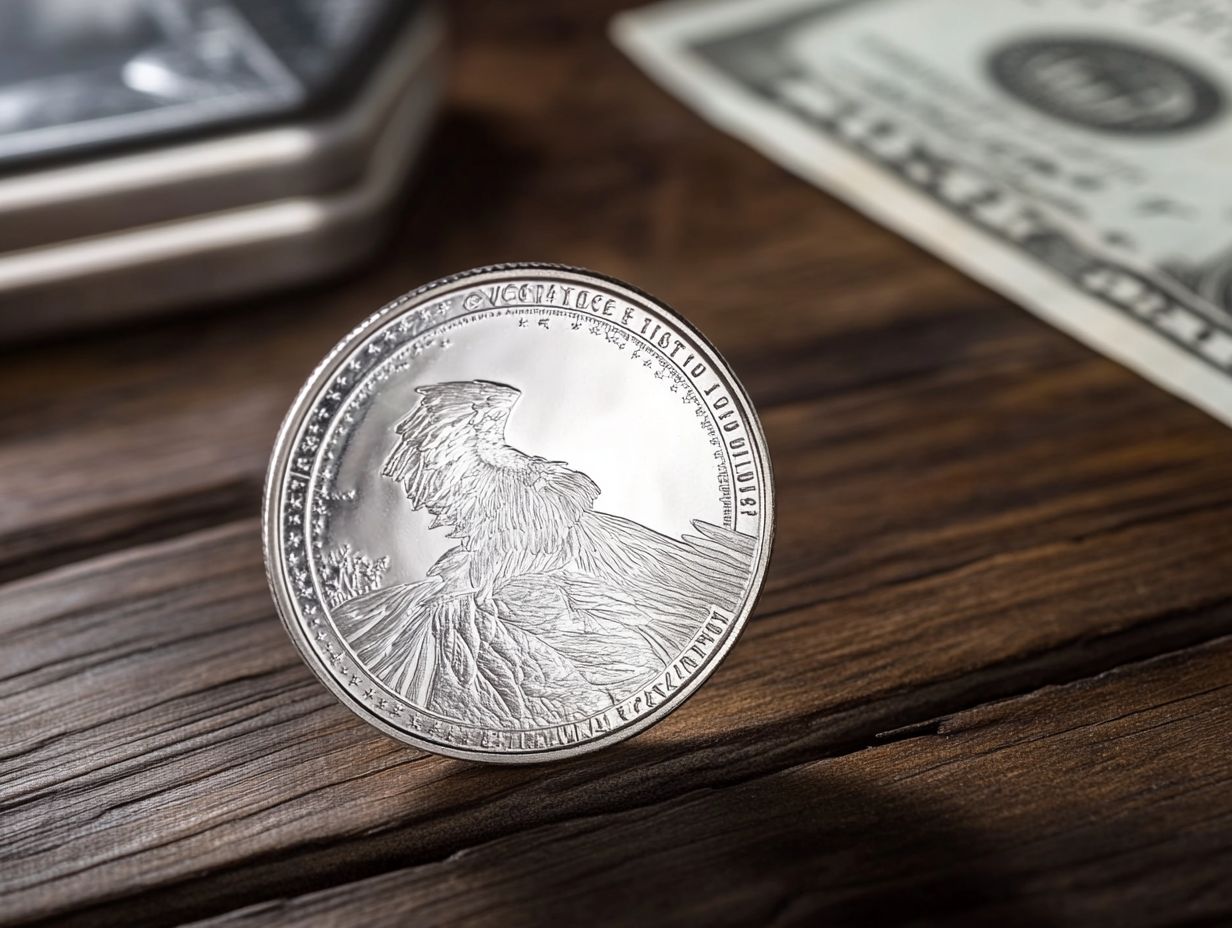
Investing in physical silver carries a unique set of risks, including market volatility, price fluctuations, and challenges tied to ensuring the authenticity and proper storage of your silver assets.
It’s crucial to think about the risk of theft, especially if you decide to keep your silver at home instead of opting for secure facilities. The liquidity of silver can be unpredictable, which means selling your assets might not always happen at your preferred price or within your desired timeframe, potentially resulting in losses.
To navigate these challenges effectively, conduct thorough research and seek guidance from financial experts. This will help you identify reputable dealers and secure storage solutions, effectively mitigating inherent risks. Stay informed about market trends to seize the best investment opportunities!
How Can One Determine the Authenticity and Purity of Physical Silver?
Determining the authenticity and purity of physical silver is essential for you as an investor, impacting both the value of silver coins and bars and the overall integrity of the silver market.
With a plethora of counterfeit products flooding the market, distinguishing genuine silver from imitations requires a comprehensive approach. Hallmarking provides crucial information about the silver’s purity and its manufacturer.
You can also use various testing techniques such as acid tests, conductivity tests, and X-ray fluorescence as valuable tools for verifying authenticity. Additionally, it s vital to source your silver from reputable channels. Established dealers, auction houses, and trusted online platforms often offer guarantees that bolster your confidence in the investment.
Are you ready to dive into the exciting world of physical silver investment? What Are the Tax Implications of Investing in Physical Silver?
Understanding the tax implications of investing in physical silver is crucial for you, the investor, as it directly affects your overall returns and shapes your strategy regarding silver coins and bars.
Navigating the intricacies of profits tax rules can feel overwhelming. Clarity on capital gains taxes is essential. When selling your silver investments, the profits you make may be subject to capital gains taxes, which can vary significantly based on how long you ve held the asset. Specific reporting requirements must be met as well when it s time to file your taxes.
By staying informed about current regulations and identifying tax-efficient strategies, you can minimize your tax liabilities, ensure compliance, and ultimately enhance the profitability of your silver investment portfolio.
How Can One Safely Store and Protect Their Physical Silver Investments?
Safely storing and protecting your physical silver investments, whether in the form of coins or bars, is essential for maintaining their value and shielding against potential risks.
You have various storage options. At-home safes allow immediate access and control, but ensure they are fireproof and secure from theft. On the other hand, bank vaults provide a higher level of security, often monitored and insured, making them a reliable choice for safeguarding your assets. Third-party storage facilities present another appealing solution, as they are specifically designed to protect precious metals.
Regardless of your choice, it’s wise to invest in insurance to cover potential loss or damage. This added layer of protection will provide you with peace of mind regarding your valuable assets.
What Are the Long-Term Prospects for Investing in Physical Silver?
The long-term prospects for investing in physical silver look quite promising for you, fueled by rising silver demand, limited supply, and an uptick in industrial applications in technology and renewable energy.
Consider how technological advancements like innovations in solar energy and electric vehicles can elevate the metal’s value. Economic trends such as inflation and currency fluctuations may also increase silver’s allure as a safe-haven asset.
The market is poised for shifts in supply dynamics, with mining output potentially struggling to keep up with steadily rising consumption. As industries increasingly pivot toward sustainability, silver is likely to play a pivotal role, reinforcing its relevance in a well-rounded investment portfolio.
Frequently Asked Questions
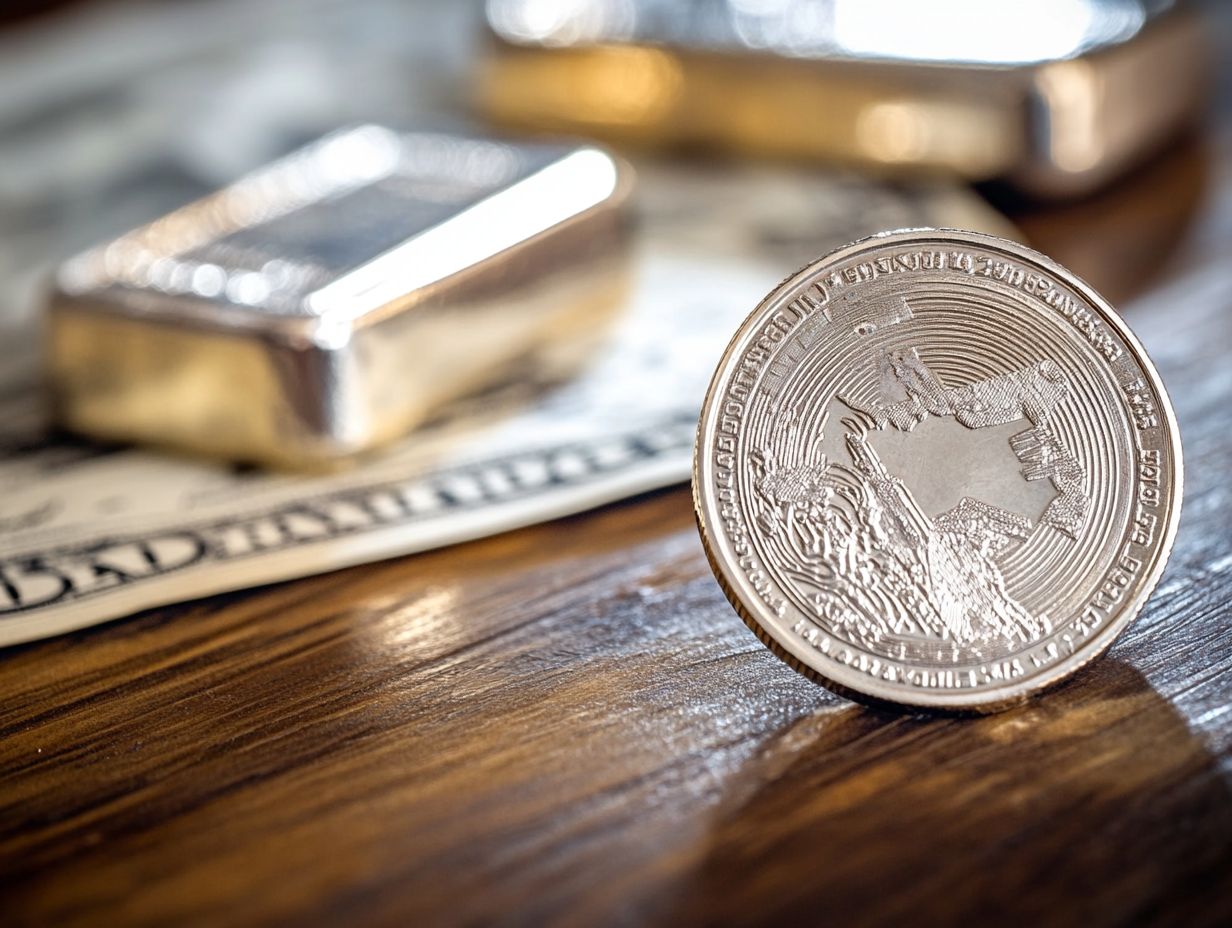
What are the 7 benefits of investing in physical silver?
The 7 benefits of investing in physical silver are diversification, protection against inflation, potential for high returns, tangible asset, hedge against economic downturns, industrial demand, and store of value.
How does investing in physical silver provide diversification?
Investing in physical silver diversifies your portfolio by adding a different asset class that moves independently from stocks and bonds. This reduces the overall risk of your portfolio.
What makes physical silver a good hedge against inflation?
Physical silver is a tangible asset, meaning it’s something you can physically touch and own. It tends to hold its value during times of inflation. As the value of currency decreases, the value of physical silver usually increases, providing a hedge against inflation.
What are the potential returns of investing in physical silver?
The potential returns of investing in physical silver can be high, as the price of silver tends to rise during economic uncertainty and market volatility. However, it is important to note that returns are not guaranteed and can fluctuate.
Why is physical silver considered a tangible asset?
Physical silver is considered a tangible asset because it is a physical item that holds value and can be held in your hand. This makes it different from paper assets, like stocks and bonds, which have no physical form.
What is the industrial demand for physical silver?
Physical silver is not only a precious metal, but it also has many industrial uses. This creates a consistent demand for silver, positively impacting its value as an investment.
How does investing in physical silver provide a store of value?
Investing in physical silver is a smart way to preserve your wealth. Unlike paper assets, silver is less affected by inflation and market swings.
This makes silver a reliable choice for long-term investment. Start considering silver today to secure your financial future!











